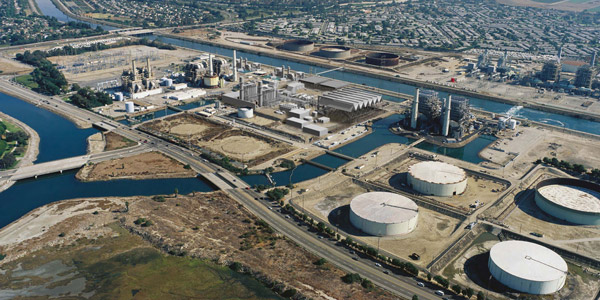By Hudson Sangree
The California Public Utilities Commission voted unanimously Thursday to recommend that some older gas-fired plants, scheduled to close next year, remain open for up to three years to prevent reliability problems.
The commission also ordered that all load-serving entities under its oversight collectively procure 3,300 MW of capacity, on a basis proportional to projected load, by August 2023.
The gas plant decision was unpopular with members of the public, local elected officials and the commissioners themselves, who said they were loath to keep the plants in service but couldn’t see another option.
The once-through-cooling (OTC) plants along the Southern Californian coast, dating from the 1950s and 1960s, are notorious for killing billions of marine organisms and sullying some of the state’s most popular beaches, including Huntington Beach in Orange County and Redondo Beach near Los Angeles.
The decision whether to keep the OTC plants open will ultimately be made by the State Water Resources Control Board in the coming weeks, though the commission’s recommendation is likely to be highly influential.
“We do not seek these extensions lightly,” Commissioner Liane Randolph said as she presented the proposal. Dozens of public speakers at recent commission meetings had opposed the proposal, many traveling from Southern California to San Francisco to address the commissioners in person, she noted.
“But as we look at the next few years, the reality is those resources [totaling 3,750 MW] are needed,” Randolph said.
Fossil fuel plants are retiring, and solar power cannot meet evening peak demand, which has shifted later in the day as solar goes offline, she said. The state needs far more storage capacity, including battery storage, to allow renewable energy to serve peak load, she said.
Other Western states are using an increasing amount of the renewable energy they produce, potentially limiting imports to California, Randolph said. California and neighbors such as Nevada and New Mexico have 100% clean-energy goals to meet by midcentury.
Orders Pro Rata Procurement
To address the expected shortfall through 2023, the CPUC’s decision Thursday also ordered all LSEs in CAISO’s balancing area to procure a total of 3,300 MW of capacity in the next three years, based on projected load share. Huge investor-owned utilities such as Southern California Edison and small community choice aggregators (CCAs) are among those included in the order.
At least 50% of the new resources must come online by Aug. 1, 2021, followed by at least 75% by Aug. 1, 2022, and 100% by Aug. 1, 2023.
The CPUC asked the LSEs to procure resources with an eye toward grid resilience in the face of public safety power shutoffs intended to prevent wildfires.
CAISO also has made meeting reliability challenges a top priority.
In a presentation in September, Mark Rothleder, CAISO’s vice president for market quality and regulatory affairs, told the ISO’s Board of Governors that the state could start to run short of electricity as soon as the summer of 2020, but the situation would likely grow more serious in 2021, when the state could fall 4,400 MW short of meeting peak demand with a 15% reserve margin.
The problem could worsen when Pacific Gas and Electric’s Diablo Canyon Power Plant, the state’s last nuclear generating station, shuts down in phases starting in 2024, he said. (See CAISO, CPUC Warn of ‘Reliability Emergency’.)
A group called Californians for Green Nuclear Power has advocated for keeping Diablo Canyon operational. Though not what some would consider clean energy, nuclear power does not produce carbon emissions. The “safe, economical and reliable Diablo Canyon Power Plant supplies 9% of California’s in-state generation,” Gene Nelson, the group’s government liaison, said in an email to RTO Insider. “If DCPP closes, there will be huge electric reliability problems for California.”
The CPUC restricted the scope of its reliability proceedings to 2023 in a “political move” to sidestep the issue of whether Diablo Canyon should remain open, Nelson said.




